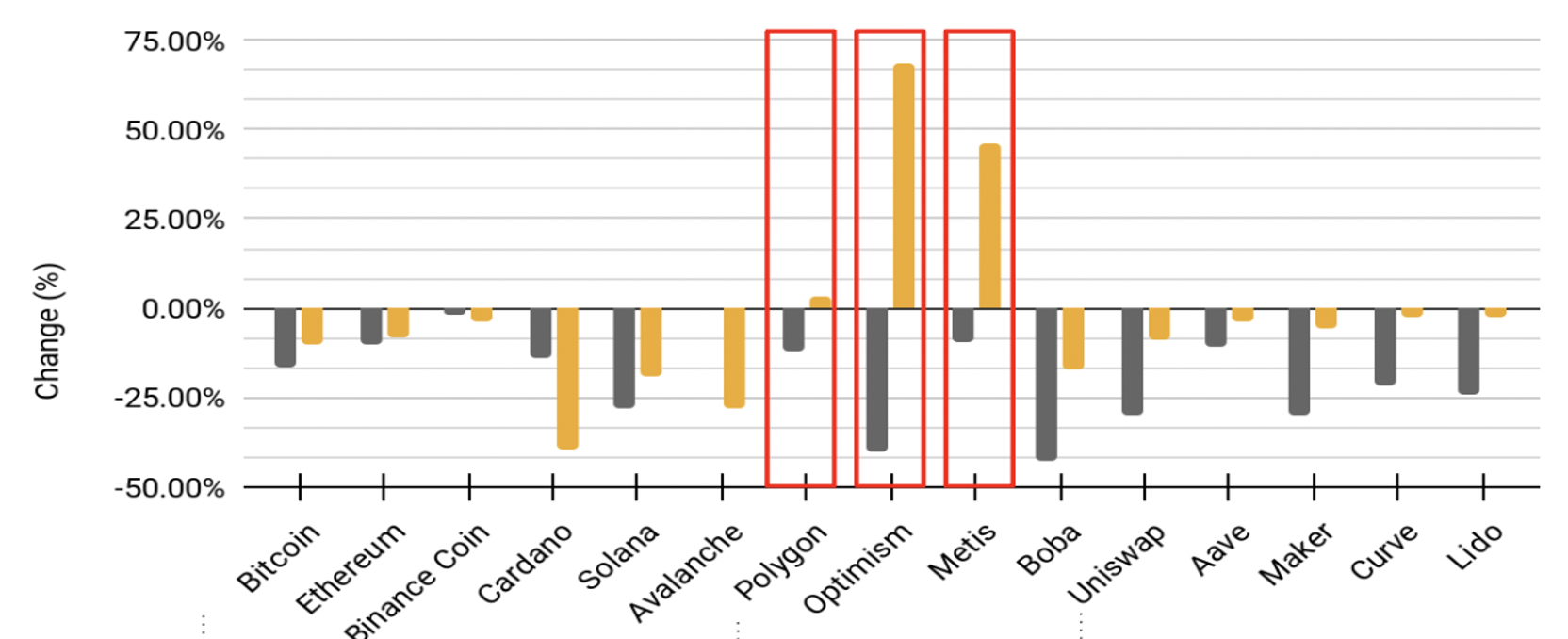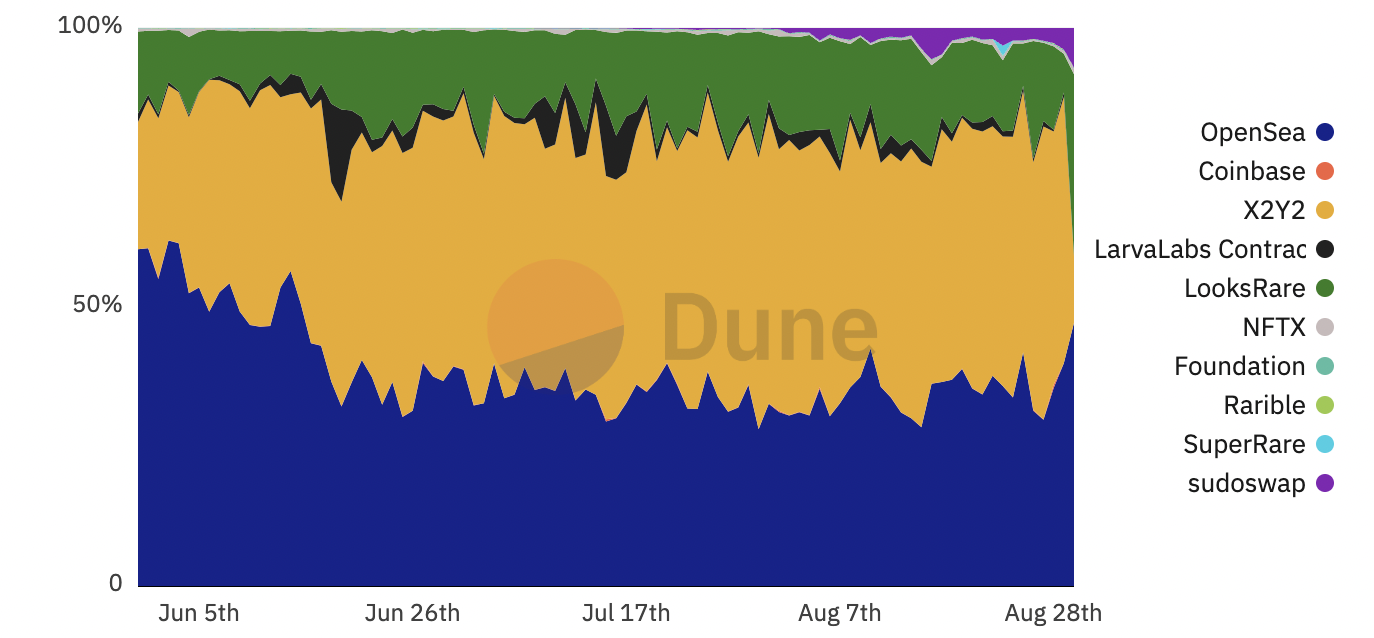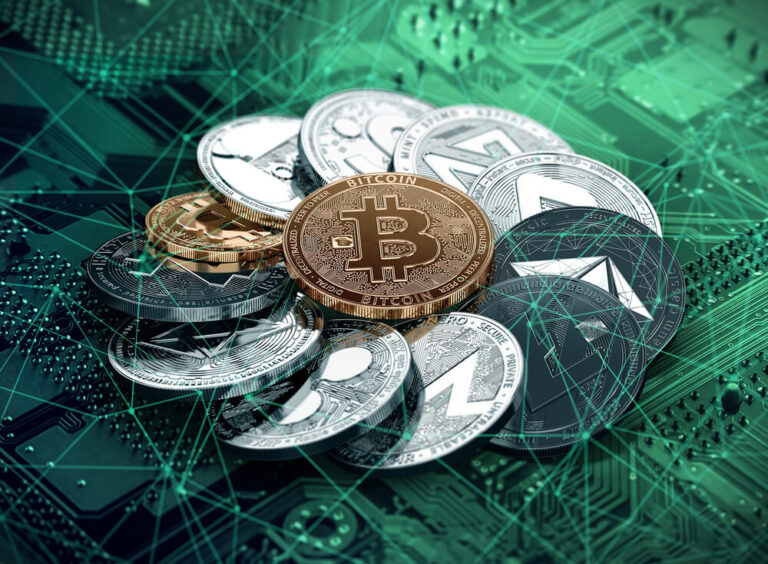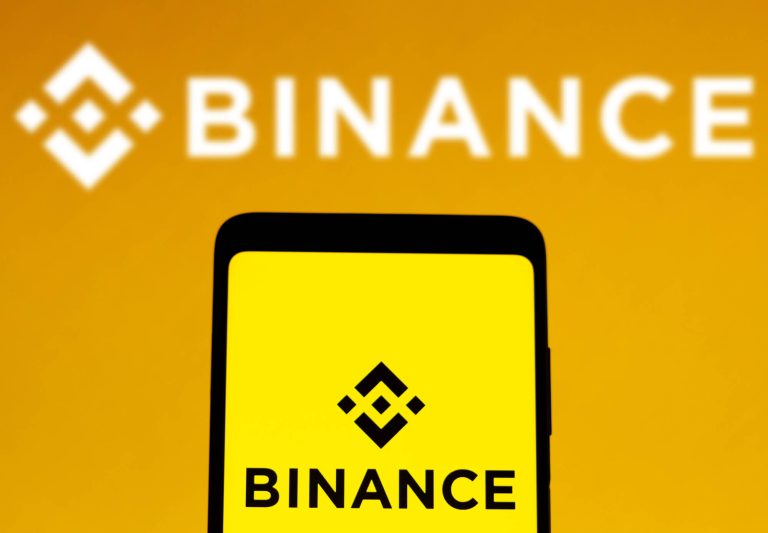A monthly review of what's happening in the crypto markets enriched with institutional research on the most important topics in the industry in cooperation with the Swiss digital asset specialist, 21Shares AG.
The total market capitalization of all cryptocurrencies fell by around 10 percent month-on-month, according to data from CoinMarketCap. The decline followed the restrictive measures envisioned by the Federal Reserve chairman in his speeches. Bitcoin (BTC) and Ethereum (ETH) fell 16.26% and 10.1%, respectively. As seen in the chart below, the three outliers of the past month seem to be Ethereum scaling solution Optimism, Metis and Polygon. They have seen growth in their total value locked (TVL) of 68.23%, 46.35%, and 2.96%, respectively, over the past month, though the returns have not been positive given the decline in underlying assets.

Macroeconomic developements
Inflation once again made waves around the world in August. Earlier this month, the Bank of England raised interest rates by 1.75% in the first week of August, the largest increase since 1995. The UK central bank's forecast for October shows inflation peaking at 13.3%. In the second week, the results of the U.S. consumer price index for July showed that inflation was 8.5%, exceeding expectations. In addition, China cut interest rates as the economy slumped and unemployment hit a record high.
In addition, the US Federal Reserve meeting minutes were also released. The pace of rate hikes would not slow until inflation cooled further. This was followed by the announcement of the chairman of the Federal Reserve - Jerome Powell - that the central bank will use all its tools " strongly " to tame inflation. However, Powell's comments not only caused Bitcoin to plummet again, but also disappointed stock markets in the U.S., Japan, China and Australia.
The second factor that influenced the crypto industry was the banning of Tornado Cash. Tornado Cash is a fully decentralized privacy protocol based on the Ethereum blockchain. The U.S. Treasury Department placed the platform on its sanctions list, which had some regulatory impact:
- The EU proposed modifications to a draft law regulating financial services to limit banks' exposure to Class 2 cryptoassets (all cryptoassets that are not stablecoins) to 1% of the institution's core capital at any time.
- The Federal Reserve expressed that banks under its jurisdiction should inform it before engaging in crypto activities.
- UK regulators could be given more powers over stablecoins and other payment-oriented cryptoassets. The bill in question will be debated for the first time in September.
Institutional adoption
At a time when crypto companies are busy building, institutional adoption is on the rise. Here are some of the key events that took place in this context:
- Crypto exchange Binance signed a memorandum of understanding with Busan to help build the blockchain industry in the South Korean city.
- Brazil's central bank selects Itau, a Sao Paulo-based bank, to build liquidity pools in decentralized finance (DeFi).
- Argentina's Mendoza province has begun accepting crypto payments for tax payments.
In September, there will be more clarity on some of the most monumental regulations, such as how non-fungible tokens (NFTs) will be affected by Europe's landmark Markets in Crypto-Assets (MiCA) framework. In addition, seven reports on Joe Biden's Executive Order will be released in September. These reports are expected to include guidance on issues related to proof-of-work mining energy consumption, the risks and benefits of cryptoassets and the feasibility of launching a U.S. central bank digital currency, among others.
Ethereum's path to Proof of Stake
All eyes were on Ethereum as the Goerli network conducted its final merge trial, successfully moving the test network to Proof of Stake (PoS). The merge will be triggered around September 15 by Terminal Total Difficulty (TTD) - a cumulative measure of the total mining power that is in the chain. As the deadline approaches and one of the TTD criteria is met, the switch to Proof of Stake is completed.
The excitement around this event could be one explanation for why Ethereum overtook Bitcoin in the options market for the first time. However, not everyone is happy with the merge. Ethereum miners may want to keep the PoW system by initiating a hard fork called the "ETHPOW bet." However, there is no real support for the Ethereum PoW blockchain outside of a majority of miners and a handful of exchanges like Poloniex and MEXC. These announced that they will list spot tokens related to the PoW fork. Meanwhile, trading platform Bitmex will launch a futures contract tracking the new fork. In contrast, Circle (USDC) and Tether (USDT), the largest stablecoin issuers in the world, have pledged their sole support for the merge. Ethermine, the largest ETH mining pool, will cease support for all planned PoW forks.
The Layer 2 Blockchain Ecosystem
Although the merge will not directly solve Ethereum's scaling issues, it sets the stage for future scaling upgrades, including sharding. In related news, Arbitrum has unveiled its latest Nova chain, an L2 built on the network's Anytrust technology and tailored for gaming and social dApps. The chain is already expected to welcome the migration of Ethereum's Reddit community points system. Meanwhile, the main network Arbitrum is expected to implement its Nitro upgrade on Aug. 31. Optimism also announced that its main upgrade, Bedrock, is now scheduled for the fourth quarter. The upgrade to the protocol is expected to help reduce withdrawal times, synchronize nodes 50 times faster and enable support for future rollup-based technologies such as ZK rollups.
Not only Ethereum, but the broader mass of Layer-1 blockchains (smart contract platforms) are taking advantage of the bear market to further expand their technologies. First, Near Protocol unveiled a new Javascript software development kit that will enable the 20 million Javascript developers around the world to write smart contracts in the legacy language. In addition, Near released testnet phase 1 of sharding, with a tentative date for the protocol's mainnet set for next month.
An early end to the ETHPoW fork?
We had already informed that some big DeFi projects have brought about the end of the potential Proof of Work fork. They will exclusively support the new PoS chain, including, for example, the blockchain company Circle, which issues the stablecoin USDC. Tether, Frax, Aave, and Chainlink followed suit, adhering to the general consensus in their decision to support the new PoS network.
These announcements by the blue chips of this industry segment make it clear that Proof of Work forks will be a highly speculative game with no real basis, as the main DeFi service providers continue to reject the potential split of the chain. If the previously mentioned blue chips do not extend their supporting infrastructure to the newly forked chains, we can expect a resurgence of so-called "ghostchains" similar to the examples of Bitcoin SV (BSV) and Bitcoin Cash (BCH). There, billions of dollars are tied up in the ecosystem but remain untapped due to the lack of a functioning DeFi ecosystem of stablecoins and basic financial platforms such as decentralized exchanges (DEXs), money markets and asset management protocols.
Subscribe to our newsletter
The best articles of the week, directly delivered into your mailbox.
Metaverse and NFTs
NFT marketplaces could not escape the general market sentiment. The trading volume of NFTs on Ethereum decreased by 17.4% compared to the previous month. The figure below shows that OpenSea, X2Y2 and LooksRare are the top 3 marketplaces on Ethereum by volume.

The BendDAO protocol faced a liquidity crisis when its reserves were emptied on August 21. The protocol is based on allowing users to borrow ETH in exchange for depositing their NFTs as collateral. Regardless of the fact that bear markets can drive NFTs into insolvency, many of the protocol's managed NFTs are now facing possible liquidation. Accordingly, BendDAO's co-founder announced some short-term improvements, including adjusting the liquidation threshold to 70 percent and making auctions last four hours. As for long-term improvements, the minutes suggested supporting bids for additional collateral in BendDAO, approaching exchanges to list collateral and supporting down payments for auctions.
Upcoming events for September
As mentioned earlier in this report, September will be an exciting month as policymakers and regulators return from the European summer recess. In addition, some important indicators will be published this month, such as the ISM manufacturing purchasing managers' index, which is a leading indicator for the U.S. economy. The Average Hourly Earnings report, which will be released the following day, is an important indicator of overall economic health, as spending correlates with market conditions. Furthermore, the much-anticipated Ethereum merge will also be conducted on September 15.








